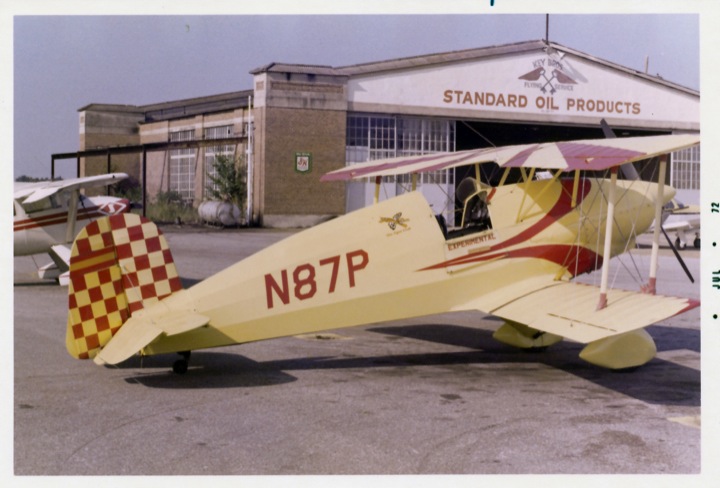This picture was taken at Key Bros. Flying Service in Meridian, Miss.

One day, this Jungmeister stopped for fuel and food. I was a line boy at that FBO and I took the pilot to the airport coffee shop or maybe it was off airport, I don't remember. Anyway, the man was very nice and friendly especially to this young 17 year old line boy. I remember helping him with something else, like bleeding the brakes or something and he asked me for my address. I didn't know who he was, but after he left, a couple of airport bums let me know. Several days later, a package arrived in the mail. The pilot had sent me an autographed picture! It was very nice of him to do so. Later in college while watching The Great Waldo Pepper, I saw him fly and almost jumped out of my seat. It was the same guy!
Unfortunately, after 38 years, I can not find that picture. Luckily, I took this one of the famous Frank Price's Jungmeister so I have some momento of the visit. I remember him as a very nice man.
That young line boy is now a 767 Captain for Delta Airlines.
Brian
----
And does the Key Brothers Flying Service ring a bell? It should:
Brothers Fred and Al Key became interested in aviation after WWI. They started doing some in the 1920s and continued their interest as the managers of the Meridian Municipal Airport, in Meridian, Mississippi.
With the onset of the Great Depression, the city of Meridian began doing whatever it could to save money. The airport was considered unnecessary, given the economic conditions, and was slated to be closed.
The Key brothers had no desire to see this happen, so they came up with a plan to draw attention to Meridian and its airport by breaking the standing flight endurance record of 23 days. At that time, air-to-air refueling was a dangerous affair. If gasoline was spilled, which often happened, if could be ignited by the hot engine.
To solve this problem, the Key brothers, along with local inventor and A. D. Hunter, invented a spill free fueling system that consisted of a valve on the end of the fuel nozzle which was opened by a probe in the neck of the fuel tank. The valve would not allow fuel to flow unless it was inserted into the fuel tank. During fueling, if the nozzle was removed from the tank, the fuel would automatically stop flowing. This nozzle was later adopted by the US Army Air Corps, and is still in use today with some modifications.
Refueling the plane wasn't their only concern. The engine needed regular maintenance during the flight in order to stay in good running order. To facilitate this, a catwalk was built so that Fred could walk out and work on the plane while it was airborn.
The Flying Keys, as the brothers later became known, lifted off in a borrowed Curtiss Robin monoplane named Ole Miss from Meridian, Mississippi's airport. For the next twenty-seven days, they flew over the Meridian vicinity. Several times each day, the crew of a similar plane would lower food and supplies to the brothers on the end of a rope, as well as supply fuel via a long flexible tube. They landed on July 1 after traveling an estimated 52,320 and used more than 6,000 gallons of fuel.
Their non-stop endurance flight lasted 653 hours, 34 minutes. The Ole Miss is permanently displayed in the National Air and Space Museum in Washington, D.C.
After this historic flight, Meridian's public airport was renamed Key Field in the brothers honor.
According to Owens, the brother's flight boosted confidence in aviation nationally. People figured if the Key brothers made their flight safely in such a small plane, then the big commercial airplanes were definitely safe.

The Key brothers later served as bomber pilots in the Pacific Theater of Operations during World War II. Fred was awarded the Distinguished Flying Cross (USA), and Al earned a Distinguished Flying Cross (USA), a Distinguished Service Cross (USA), an Air Medal, a Distinguished Service Cross (UK) and seven Bronze Stars for participating in combat. They both had distinguished careers--Al remained in the Air Force until his retirement in 1960 at the rank of full Colonel, after which he was elected Mayor of Meridian, and Fred ran the Key Brothers Flying Service at Key Field until his death in 1971. The cutoff valve developed for the Keys by A.D. Hunter was an important innovation for national defense, being the precursor of those used by modern tanker airplanes, such as the KC-135 Stratotanker, that keep bomber and fighter aircraft in the air. Today, with only slight modifications, U.S. Air Force and Strategic Air Command airplanes use the valve that Hunter invented.

